Globalization's Effects on Crime and Criminal Justice Systems
VerifiedAdded on 2023/06/11
|7
|1853
|141
Essay
AI Summary
This essay examines the multifaceted impact of globalization on crime and criminal justice systems, focusing on concepts like punitiveness and the complexities of comparative criminology. It analyzes various models, including the welfare model, and their effectiveness in different national contexts, using the Netherlands as a key example. The essay further discusses how globalization influences international crime, human rights, and the need for coordinated global actions against transnational criminal activities. It also addresses critical perspectives on defining crime in relation to human rights violations and the political dimensions of criminology. The study argues for broadening the scope of investigation beyond conventional factors, emphasizing the importance of local historical backdrops and cultural standards in understanding crime and justice in a globalized world. Desklib provides this essay and other resources for students.
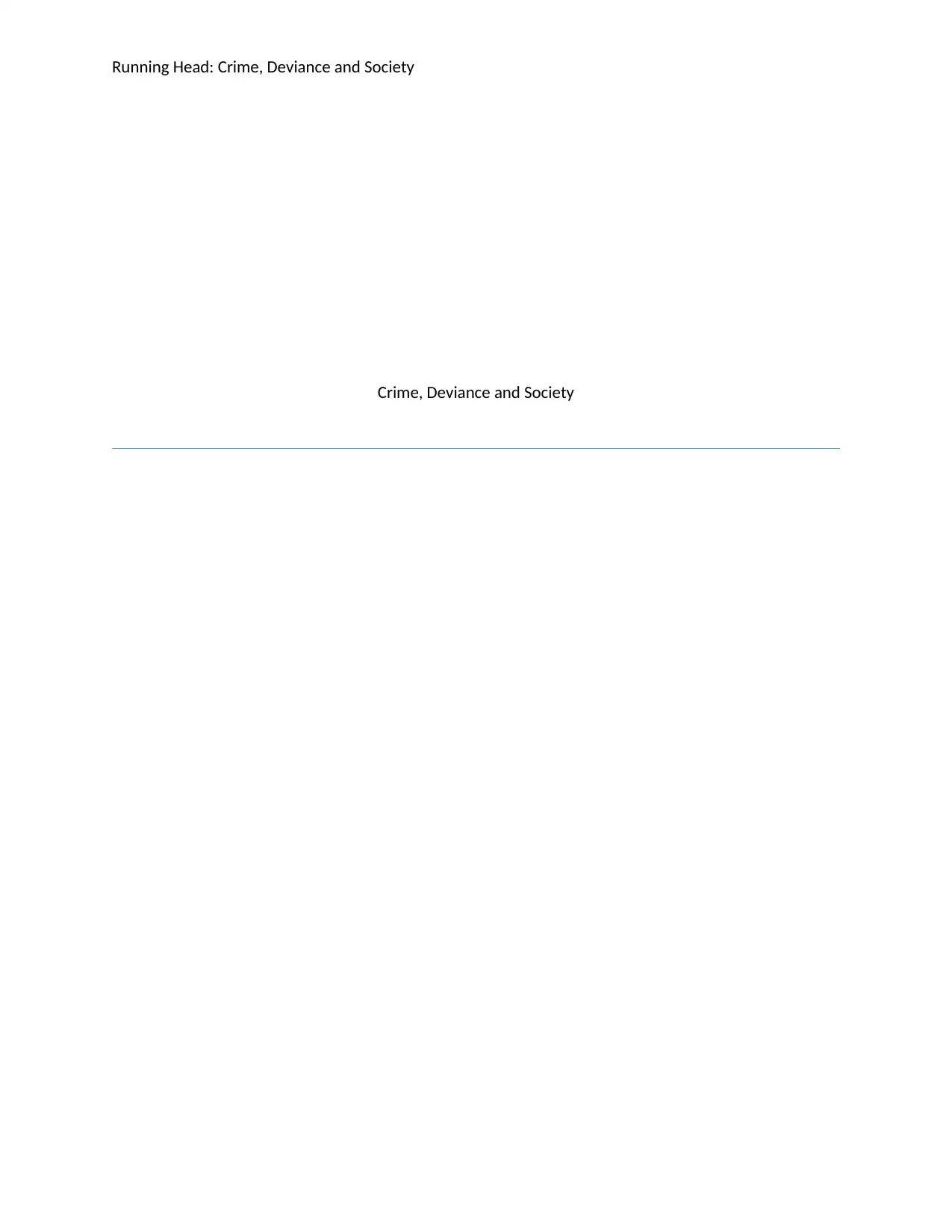
Running Head: Crime, Deviance and Society
Crime, Deviance and Society
Crime, Deviance and Society
Paraphrase This Document
Need a fresh take? Get an instant paraphrase of this document with our AI Paraphraser
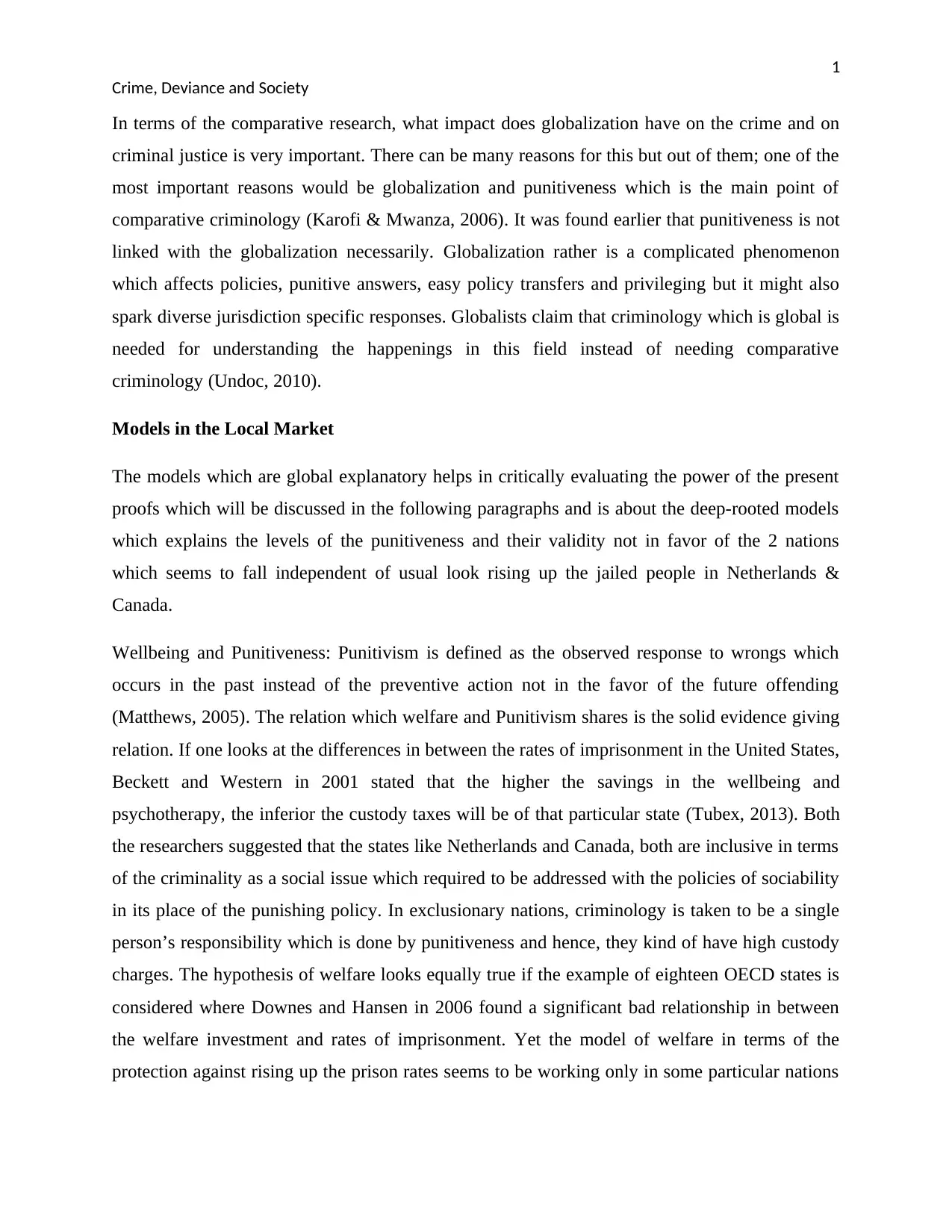
1
Crime, Deviance and Society
In terms of the comparative research, what impact does globalization have on the crime and on
criminal justice is very important. There can be many reasons for this but out of them; one of the
most important reasons would be globalization and punitiveness which is the main point of
comparative criminology (Karofi & Mwanza, 2006). It was found earlier that punitiveness is not
linked with the globalization necessarily. Globalization rather is a complicated phenomenon
which affects policies, punitive answers, easy policy transfers and privileging but it might also
spark diverse jurisdiction specific responses. Globalists claim that criminology which is global is
needed for understanding the happenings in this field instead of needing comparative
criminology (Undoc, 2010).
Models in the Local Market
The models which are global explanatory helps in critically evaluating the power of the present
proofs which will be discussed in the following paragraphs and is about the deep-rooted models
which explains the levels of the punitiveness and their validity not in favor of the 2 nations
which seems to fall independent of usual look rising up the jailed people in Netherlands &
Canada.
Wellbeing and Punitiveness: Punitivism is defined as the observed response to wrongs which
occurs in the past instead of the preventive action not in the favor of the future offending
(Matthews, 2005). The relation which welfare and Punitivism shares is the solid evidence giving
relation. If one looks at the differences in between the rates of imprisonment in the United States,
Beckett and Western in 2001 stated that the higher the savings in the wellbeing and
psychotherapy, the inferior the custody taxes will be of that particular state (Tubex, 2013). Both
the researchers suggested that the states like Netherlands and Canada, both are inclusive in terms
of the criminality as a social issue which required to be addressed with the policies of sociability
in its place of the punishing policy. In exclusionary nations, criminology is taken to be a single
person’s responsibility which is done by punitiveness and hence, they kind of have high custody
charges. The hypothesis of welfare looks equally true if the example of eighteen OECD states is
considered where Downes and Hansen in 2006 found a significant bad relationship in between
the welfare investment and rates of imprisonment. Yet the model of welfare in terms of the
protection against rising up the prison rates seems to be working only in some particular nations
Crime, Deviance and Society
In terms of the comparative research, what impact does globalization have on the crime and on
criminal justice is very important. There can be many reasons for this but out of them; one of the
most important reasons would be globalization and punitiveness which is the main point of
comparative criminology (Karofi & Mwanza, 2006). It was found earlier that punitiveness is not
linked with the globalization necessarily. Globalization rather is a complicated phenomenon
which affects policies, punitive answers, easy policy transfers and privileging but it might also
spark diverse jurisdiction specific responses. Globalists claim that criminology which is global is
needed for understanding the happenings in this field instead of needing comparative
criminology (Undoc, 2010).
Models in the Local Market
The models which are global explanatory helps in critically evaluating the power of the present
proofs which will be discussed in the following paragraphs and is about the deep-rooted models
which explains the levels of the punitiveness and their validity not in favor of the 2 nations
which seems to fall independent of usual look rising up the jailed people in Netherlands &
Canada.
Wellbeing and Punitiveness: Punitivism is defined as the observed response to wrongs which
occurs in the past instead of the preventive action not in the favor of the future offending
(Matthews, 2005). The relation which welfare and Punitivism shares is the solid evidence giving
relation. If one looks at the differences in between the rates of imprisonment in the United States,
Beckett and Western in 2001 stated that the higher the savings in the wellbeing and
psychotherapy, the inferior the custody taxes will be of that particular state (Tubex, 2013). Both
the researchers suggested that the states like Netherlands and Canada, both are inclusive in terms
of the criminality as a social issue which required to be addressed with the policies of sociability
in its place of the punishing policy. In exclusionary nations, criminology is taken to be a single
person’s responsibility which is done by punitiveness and hence, they kind of have high custody
charges. The hypothesis of welfare looks equally true if the example of eighteen OECD states is
considered where Downes and Hansen in 2006 found a significant bad relationship in between
the welfare investment and rates of imprisonment. Yet the model of welfare in terms of the
protection against rising up the prison rates seems to be working only in some particular nations
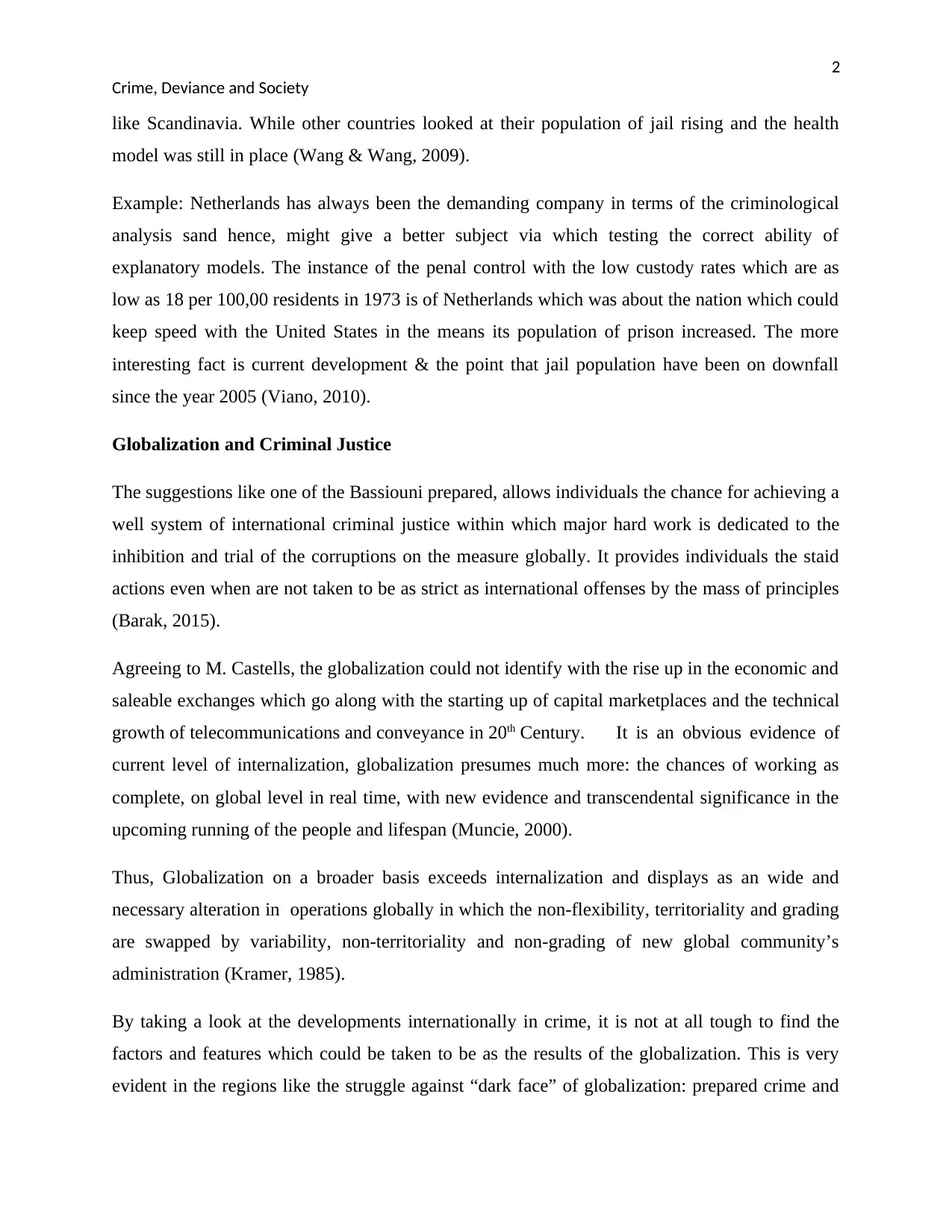
2
Crime, Deviance and Society
like Scandinavia. While other countries looked at their population of jail rising and the health
model was still in place (Wang & Wang, 2009).
Example: Netherlands has always been the demanding company in terms of the criminological
analysis sand hence, might give a better subject via which testing the correct ability of
explanatory models. The instance of the penal control with the low custody rates which are as
low as 18 per 100,00 residents in 1973 is of Netherlands which was about the nation which could
keep speed with the United States in the means its population of prison increased. The more
interesting fact is current development & the point that jail population have been on downfall
since the year 2005 (Viano, 2010).
Globalization and Criminal Justice
The suggestions like one of the Bassiouni prepared, allows individuals the chance for achieving a
well system of international criminal justice within which major hard work is dedicated to the
inhibition and trial of the corruptions on the measure globally. It provides individuals the staid
actions even when are not taken to be as strict as international offenses by the mass of principles
(Barak, 2015).
Agreeing to M. Castells, the globalization could not identify with the rise up in the economic and
saleable exchanges which go along with the starting up of capital marketplaces and the technical
growth of telecommunications and conveyance in 20th Century. It is an obvious evidence of
current level of internalization, globalization presumes much more: the chances of working as
complete, on global level in real time, with new evidence and transcendental significance in the
upcoming running of the people and lifespan (Muncie, 2000).
Thus, Globalization on a broader basis exceeds internalization and displays as an wide and
necessary alteration in operations globally in which the non-flexibility, territoriality and grading
are swapped by variability, non-territoriality and non-grading of new global community’s
administration (Kramer, 1985).
By taking a look at the developments internationally in crime, it is not at all tough to find the
factors and features which could be taken to be as the results of the globalization. This is very
evident in the regions like the struggle against “dark face” of globalization: prepared crime and
Crime, Deviance and Society
like Scandinavia. While other countries looked at their population of jail rising and the health
model was still in place (Wang & Wang, 2009).
Example: Netherlands has always been the demanding company in terms of the criminological
analysis sand hence, might give a better subject via which testing the correct ability of
explanatory models. The instance of the penal control with the low custody rates which are as
low as 18 per 100,00 residents in 1973 is of Netherlands which was about the nation which could
keep speed with the United States in the means its population of prison increased. The more
interesting fact is current development & the point that jail population have been on downfall
since the year 2005 (Viano, 2010).
Globalization and Criminal Justice
The suggestions like one of the Bassiouni prepared, allows individuals the chance for achieving a
well system of international criminal justice within which major hard work is dedicated to the
inhibition and trial of the corruptions on the measure globally. It provides individuals the staid
actions even when are not taken to be as strict as international offenses by the mass of principles
(Barak, 2015).
Agreeing to M. Castells, the globalization could not identify with the rise up in the economic and
saleable exchanges which go along with the starting up of capital marketplaces and the technical
growth of telecommunications and conveyance in 20th Century. It is an obvious evidence of
current level of internalization, globalization presumes much more: the chances of working as
complete, on global level in real time, with new evidence and transcendental significance in the
upcoming running of the people and lifespan (Muncie, 2000).
Thus, Globalization on a broader basis exceeds internalization and displays as an wide and
necessary alteration in operations globally in which the non-flexibility, territoriality and grading
are swapped by variability, non-territoriality and non-grading of new global community’s
administration (Kramer, 1985).
By taking a look at the developments internationally in crime, it is not at all tough to find the
factors and features which could be taken to be as the results of the globalization. This is very
evident in the regions like the struggle against “dark face” of globalization: prepared crime and
⊘ This is a preview!⊘
Do you want full access?
Subscribe today to unlock all pages.

Trusted by 1+ million students worldwide
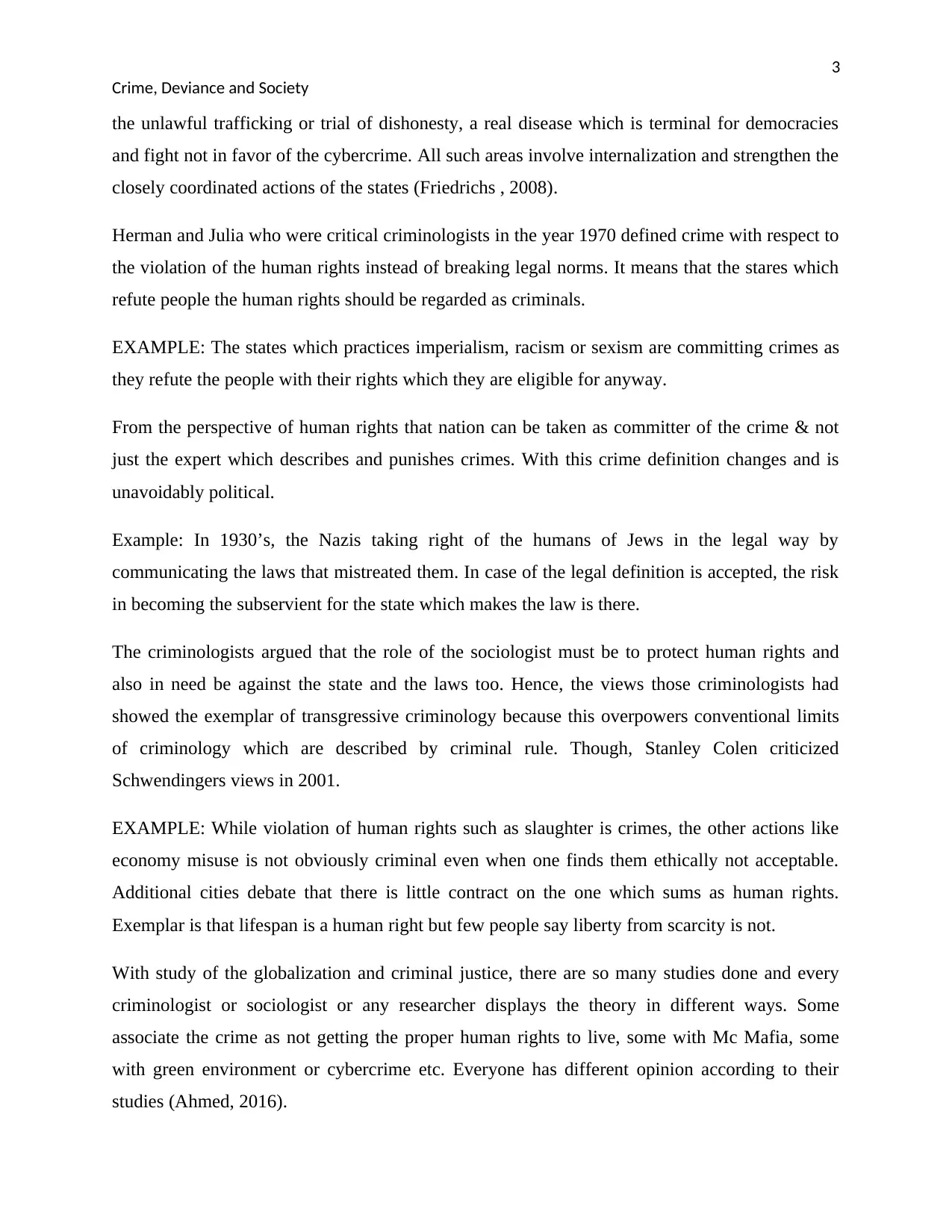
3
Crime, Deviance and Society
the unlawful trafficking or trial of dishonesty, a real disease which is terminal for democracies
and fight not in favor of the cybercrime. All such areas involve internalization and strengthen the
closely coordinated actions of the states (Friedrichs , 2008).
Herman and Julia who were critical criminologists in the year 1970 defined crime with respect to
the violation of the human rights instead of breaking legal norms. It means that the stares which
refute people the human rights should be regarded as criminals.
EXAMPLE: The states which practices imperialism, racism or sexism are committing crimes as
they refute the people with their rights which they are eligible for anyway.
From the perspective of human rights that nation can be taken as committer of the crime & not
just the expert which describes and punishes crimes. With this crime definition changes and is
unavoidably political.
Example: In 1930’s, the Nazis taking right of the humans of Jews in the legal way by
communicating the laws that mistreated them. In case of the legal definition is accepted, the risk
in becoming the subservient for the state which makes the law is there.
The criminologists argued that the role of the sociologist must be to protect human rights and
also in need be against the state and the laws too. Hence, the views those criminologists had
showed the exemplar of transgressive criminology because this overpowers conventional limits
of criminology which are described by criminal rule. Though, Stanley Colen criticized
Schwendingers views in 2001.
EXAMPLE: While violation of human rights such as slaughter is crimes, the other actions like
economy misuse is not obviously criminal even when one finds them ethically not acceptable.
Additional cities debate that there is little contract on the one which sums as human rights.
Exemplar is that lifespan is a human right but few people say liberty from scarcity is not.
With study of the globalization and criminal justice, there are so many studies done and every
criminologist or sociologist or any researcher displays the theory in different ways. Some
associate the crime as not getting the proper human rights to live, some with Mc Mafia, some
with green environment or cybercrime etc. Everyone has different opinion according to their
studies (Ahmed, 2016).
Crime, Deviance and Society
the unlawful trafficking or trial of dishonesty, a real disease which is terminal for democracies
and fight not in favor of the cybercrime. All such areas involve internalization and strengthen the
closely coordinated actions of the states (Friedrichs , 2008).
Herman and Julia who were critical criminologists in the year 1970 defined crime with respect to
the violation of the human rights instead of breaking legal norms. It means that the stares which
refute people the human rights should be regarded as criminals.
EXAMPLE: The states which practices imperialism, racism or sexism are committing crimes as
they refute the people with their rights which they are eligible for anyway.
From the perspective of human rights that nation can be taken as committer of the crime & not
just the expert which describes and punishes crimes. With this crime definition changes and is
unavoidably political.
Example: In 1930’s, the Nazis taking right of the humans of Jews in the legal way by
communicating the laws that mistreated them. In case of the legal definition is accepted, the risk
in becoming the subservient for the state which makes the law is there.
The criminologists argued that the role of the sociologist must be to protect human rights and
also in need be against the state and the laws too. Hence, the views those criminologists had
showed the exemplar of transgressive criminology because this overpowers conventional limits
of criminology which are described by criminal rule. Though, Stanley Colen criticized
Schwendingers views in 2001.
EXAMPLE: While violation of human rights such as slaughter is crimes, the other actions like
economy misuse is not obviously criminal even when one finds them ethically not acceptable.
Additional cities debate that there is little contract on the one which sums as human rights.
Exemplar is that lifespan is a human right but few people say liberty from scarcity is not.
With study of the globalization and criminal justice, there are so many studies done and every
criminologist or sociologist or any researcher displays the theory in different ways. Some
associate the crime as not getting the proper human rights to live, some with Mc Mafia, some
with green environment or cybercrime etc. Everyone has different opinion according to their
studies (Ahmed, 2016).
Paraphrase This Document
Need a fresh take? Get an instant paraphrase of this document with our AI Paraphraser
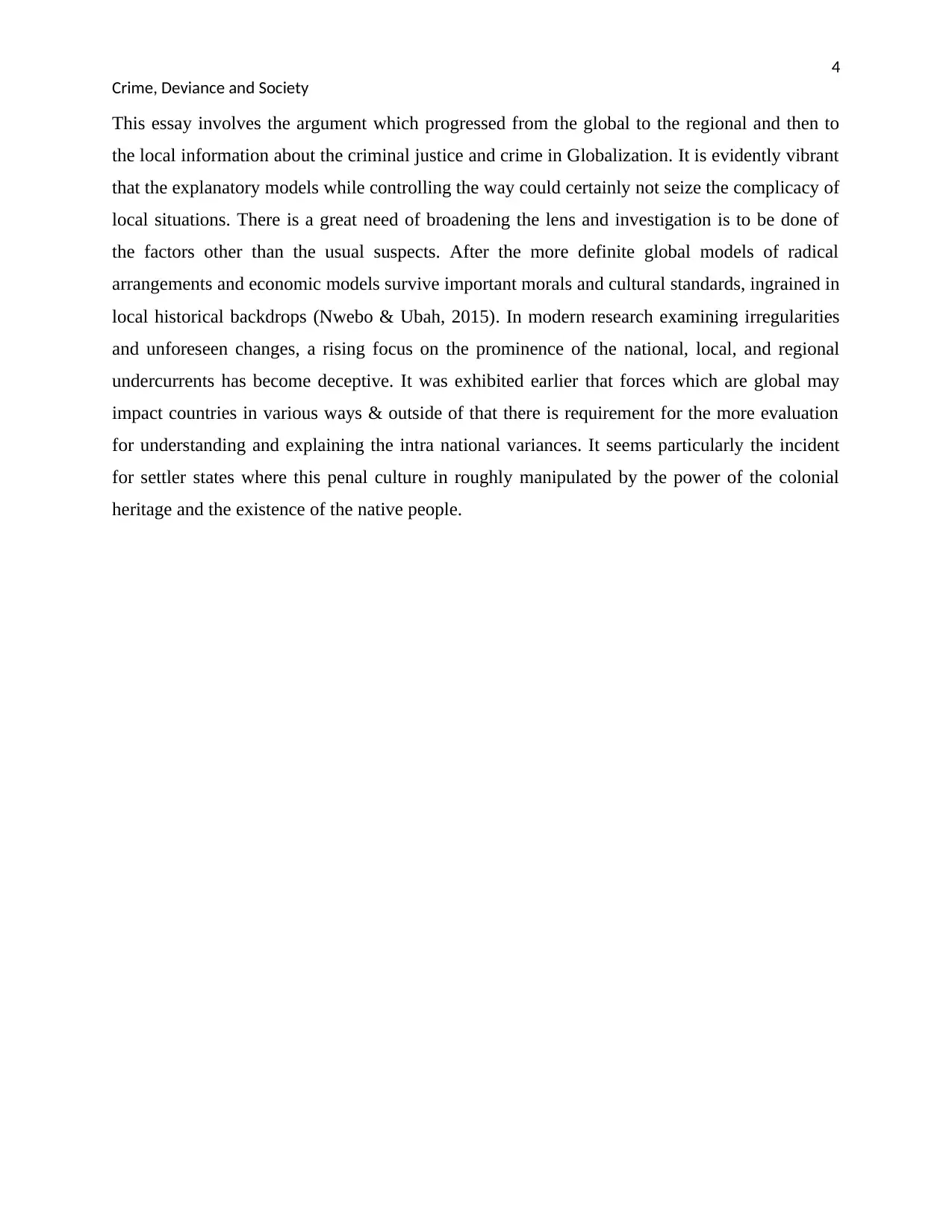
4
Crime, Deviance and Society
This essay involves the argument which progressed from the global to the regional and then to
the local information about the criminal justice and crime in Globalization. It is evidently vibrant
that the explanatory models while controlling the way could certainly not seize the complicacy of
local situations. There is a great need of broadening the lens and investigation is to be done of
the factors other than the usual suspects. After the more definite global models of radical
arrangements and economic models survive important morals and cultural standards, ingrained in
local historical backdrops (Nwebo & Ubah, 2015). In modern research examining irregularities
and unforeseen changes, a rising focus on the prominence of the national, local, and regional
undercurrents has become deceptive. It was exhibited earlier that forces which are global may
impact countries in various ways & outside of that there is requirement for the more evaluation
for understanding and explaining the intra national variances. It seems particularly the incident
for settler states where this penal culture in roughly manipulated by the power of the colonial
heritage and the existence of the native people.
Crime, Deviance and Society
This essay involves the argument which progressed from the global to the regional and then to
the local information about the criminal justice and crime in Globalization. It is evidently vibrant
that the explanatory models while controlling the way could certainly not seize the complicacy of
local situations. There is a great need of broadening the lens and investigation is to be done of
the factors other than the usual suspects. After the more definite global models of radical
arrangements and economic models survive important morals and cultural standards, ingrained in
local historical backdrops (Nwebo & Ubah, 2015). In modern research examining irregularities
and unforeseen changes, a rising focus on the prominence of the national, local, and regional
undercurrents has become deceptive. It was exhibited earlier that forces which are global may
impact countries in various ways & outside of that there is requirement for the more evaluation
for understanding and explaining the intra national variances. It seems particularly the incident
for settler states where this penal culture in roughly manipulated by the power of the colonial
heritage and the existence of the native people.
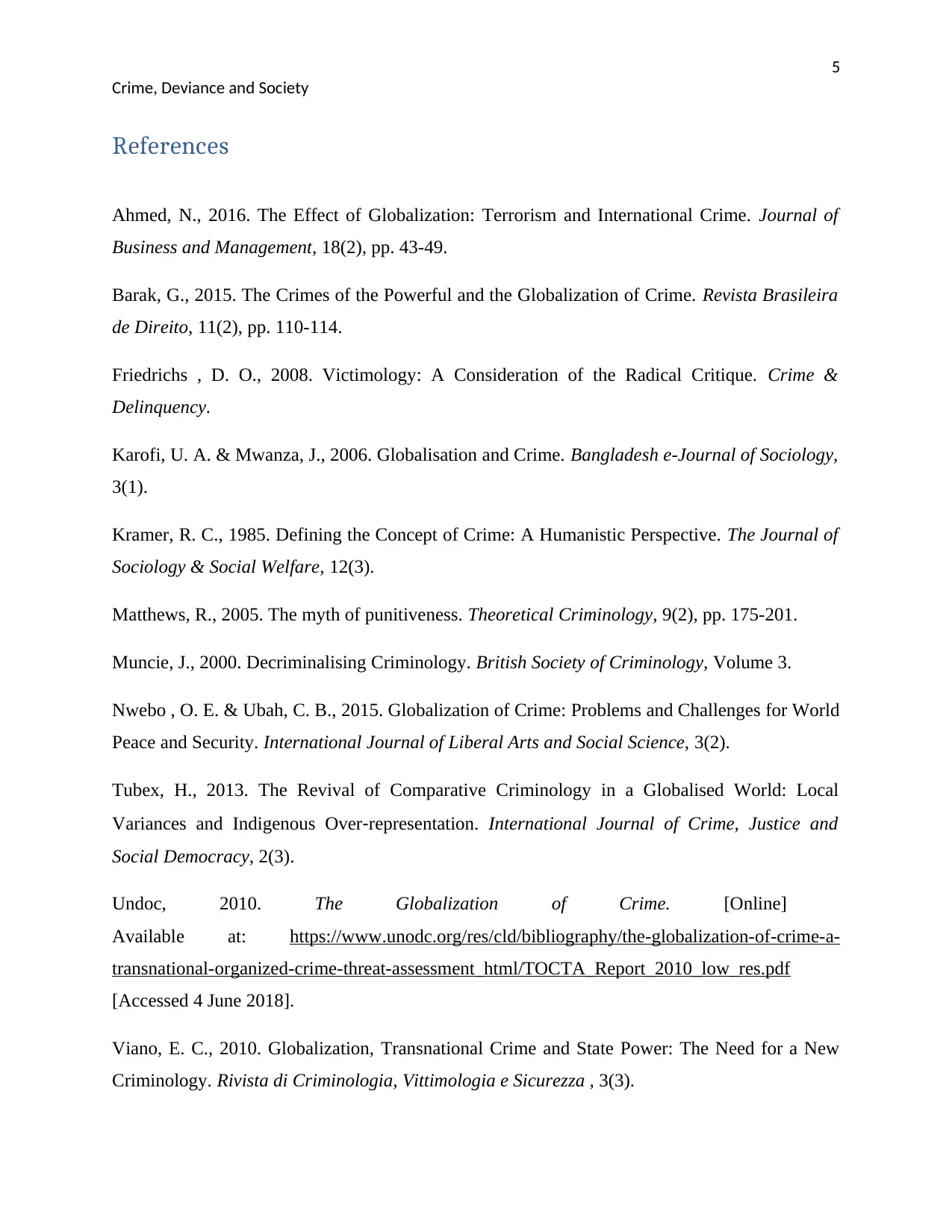
5
Crime, Deviance and Society
References
Ahmed, N., 2016. The Effect of Globalization: Terrorism and International Crime. Journal of
Business and Management, 18(2), pp. 43-49.
Barak, G., 2015. The Crimes of the Powerful and the Globalization of Crime. Revista Brasileira
de Direito, 11(2), pp. 110-114.
Friedrichs , D. O., 2008. Victimology: A Consideration of the Radical Critique. Crime &
Delinquency.
Karofi, U. A. & Mwanza, J., 2006. Globalisation and Crime. Bangladesh e-Journal of Sociology,
3(1).
Kramer, R. C., 1985. Defining the Concept of Crime: A Humanistic Perspective. The Journal of
Sociology & Social Welfare, 12(3).
Matthews, R., 2005. The myth of punitiveness. Theoretical Criminology, 9(2), pp. 175-201.
Muncie, J., 2000. Decriminalising Criminology. British Society of Criminology, Volume 3.
Nwebo , O. E. & Ubah, C. B., 2015. Globalization of Crime: Problems and Challenges for World
Peace and Security. International Journal of Liberal Arts and Social Science, 3(2).
Tubex, H., 2013. The Revival of Comparative Criminology in a Globalised World: Local
Variances and Indigenous Over‐representation. International Journal of Crime, Justice and
Social Democracy, 2(3).
Undoc, 2010. The Globalization of Crime. [Online]
Available at: https://www.unodc.org/res/cld/bibliography/the-globalization-of-crime-a-
transnational-organized-crime-threat-assessment_html/TOCTA_Report_2010_low_res.pdf
[Accessed 4 June 2018].
Viano, E. C., 2010. Globalization, Transnational Crime and State Power: The Need for a New
Criminology. Rivista di Criminologia, Vittimologia e Sicurezza , 3(3).
Crime, Deviance and Society
References
Ahmed, N., 2016. The Effect of Globalization: Terrorism and International Crime. Journal of
Business and Management, 18(2), pp. 43-49.
Barak, G., 2015. The Crimes of the Powerful and the Globalization of Crime. Revista Brasileira
de Direito, 11(2), pp. 110-114.
Friedrichs , D. O., 2008. Victimology: A Consideration of the Radical Critique. Crime &
Delinquency.
Karofi, U. A. & Mwanza, J., 2006. Globalisation and Crime. Bangladesh e-Journal of Sociology,
3(1).
Kramer, R. C., 1985. Defining the Concept of Crime: A Humanistic Perspective. The Journal of
Sociology & Social Welfare, 12(3).
Matthews, R., 2005. The myth of punitiveness. Theoretical Criminology, 9(2), pp. 175-201.
Muncie, J., 2000. Decriminalising Criminology. British Society of Criminology, Volume 3.
Nwebo , O. E. & Ubah, C. B., 2015. Globalization of Crime: Problems and Challenges for World
Peace and Security. International Journal of Liberal Arts and Social Science, 3(2).
Tubex, H., 2013. The Revival of Comparative Criminology in a Globalised World: Local
Variances and Indigenous Over‐representation. International Journal of Crime, Justice and
Social Democracy, 2(3).
Undoc, 2010. The Globalization of Crime. [Online]
Available at: https://www.unodc.org/res/cld/bibliography/the-globalization-of-crime-a-
transnational-organized-crime-threat-assessment_html/TOCTA_Report_2010_low_res.pdf
[Accessed 4 June 2018].
Viano, E. C., 2010. Globalization, Transnational Crime and State Power: The Need for a New
Criminology. Rivista di Criminologia, Vittimologia e Sicurezza , 3(3).
⊘ This is a preview!⊘
Do you want full access?
Subscribe today to unlock all pages.

Trusted by 1+ million students worldwide
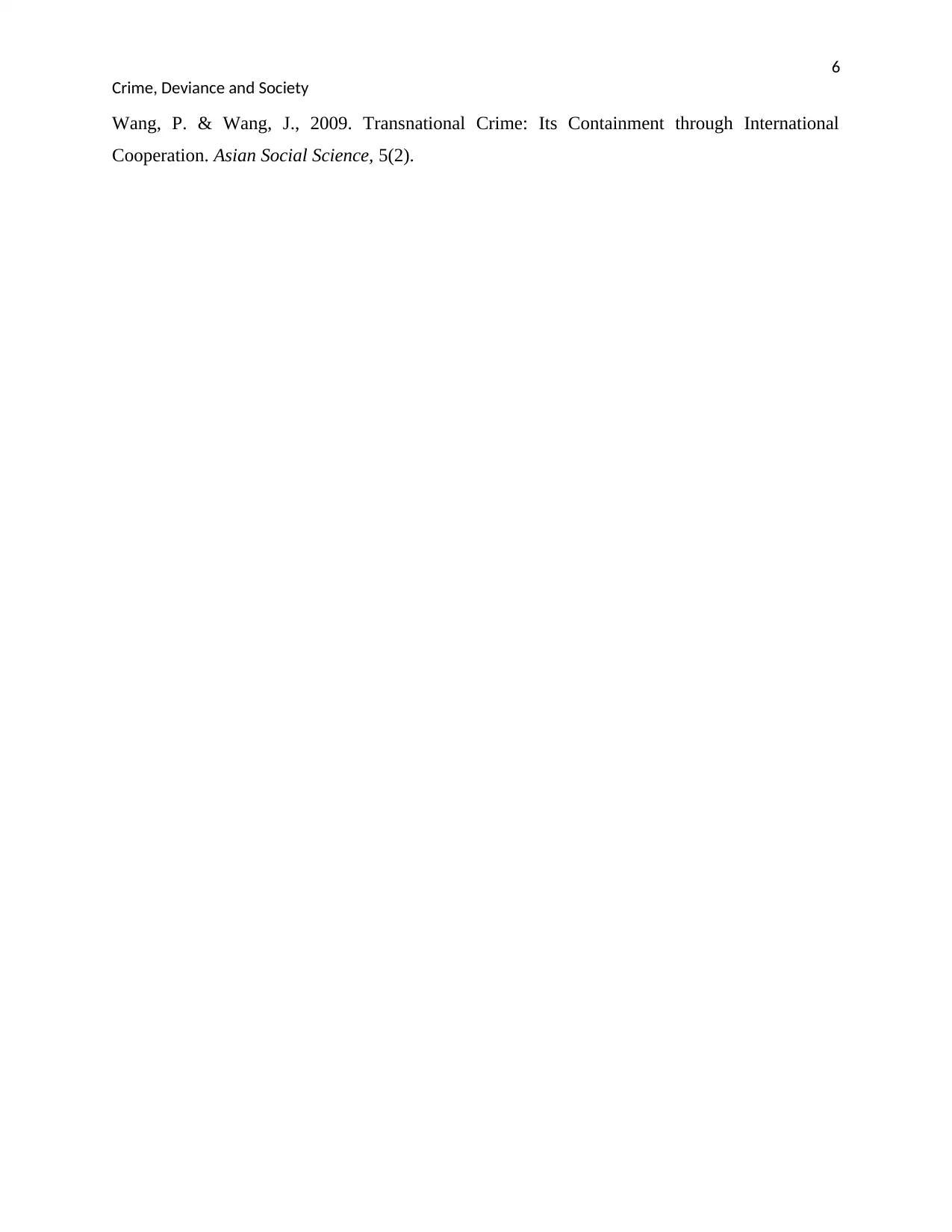
6
Crime, Deviance and Society
Wang, P. & Wang, J., 2009. Transnational Crime: Its Containment through International
Cooperation. Asian Social Science, 5(2).
Crime, Deviance and Society
Wang, P. & Wang, J., 2009. Transnational Crime: Its Containment through International
Cooperation. Asian Social Science, 5(2).
1 out of 7
Your All-in-One AI-Powered Toolkit for Academic Success.
+13062052269
info@desklib.com
Available 24*7 on WhatsApp / Email
![[object Object]](/_next/static/media/star-bottom.7253800d.svg)
Unlock your academic potential
Copyright © 2020–2025 A2Z Services. All Rights Reserved. Developed and managed by ZUCOL.

